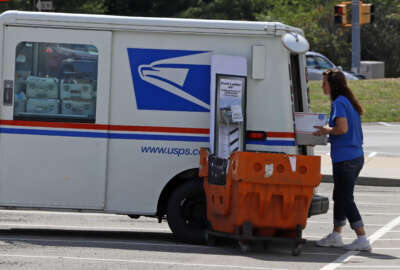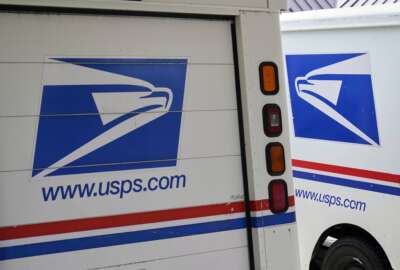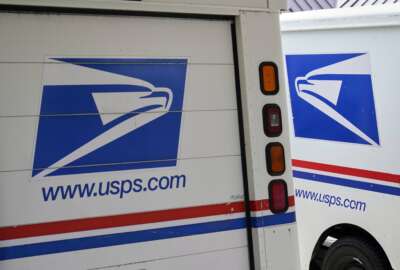

Although the Postal Service did the requisite environmental impact statement, it wasn't good enough for stakeholders.
For the Postal Service, acquisition of new delivery vehicles has been a long, convoluted affair. It’s not over. Although the Postal Service did the requisite environmental impact statement, it wasn’t good enough for stakeholders. USPS faces lawsuits. Somehow it all has to do with gas engine versus electric. For details and what has to happen next, Federal Drive with Tom Temin spoke with Josh Bartzen, the Audit Director of the Postal Service Office of Inspector General.
Interview Transcript:
Tom Temin And what is the status here? They let a contract some time ago, I think in late 2021, for a fleet of vehicles, some were to be electric, some were to be gasoline. As required by law for more than 50 years, they submitted an environmental impact statement. Then what happened?
Josh Bartzen It’s a great question, Tom. And just like a lot of things that this acquisition process is, you know, you brought the word convoluted. It’s very complex. There’s no doubt about it. And there’s a lot of stakeholders. And right now, as simple as I’m going to say, it’s going to be the Postal Service is on the path of still purchasing new vehicles with some combination of internal combustion engines and electric vehicles. And it’s one of those things, at the end of the day, the Postal Service has a massive vehicle fleet, over 235,000 vehicles, and they get old. And at some point, some of these vehicles need to be replaced. So along that process, it’s not like we can snap fingers and stuff happens overnight. There is a process to it. So like you said, the Postal Service has issued the environmental impact statement, they’re subsequently doing a environmental impact statement to address some of the issues that other stakeholders have raised. But of course some of the issues that we identified in our report as well.
Tom Temin And who are these stakeholders that filed lawsuits and on what basis?
Josh Bartzen You know what, those parties, it’s kind of up to them in terms of who’s filing. That’s their ability to do so. From our perspective, we just tried to stick with the information that the Postal Service was sharing related to the acquisition process, some of the publicly available information, and then just do our work in terms of consulting with our internal general counsel. And we also had a contractor on this work help us out. So it was kind of a culmination of work from our side just to kind of assess the entire environment of which these decisions and this analysis was being made.
Tom Temin But your recommendation that they do a supplemental EIS, environmental impact statement, is a result of issues raised by these lawsuits from external groups.
Josh Bartzen And that’s one of the things, I guess from the Postal Service’s perspective, they have a big delivery realignment going on, too. So it’s one of those things it becomes a kind of chicken or the egg type endeavor of with the Postal Service modernizing its delivery network, you want those vehicles to kind of align with what you view that future network to be. So in terms of the reasoning for their supplemental EIS, I’m sure it happened for a lot of factors. And that may be a better question for the Postal Service to answer. Again, we think that issuance of the supplemental is a great opportunity to address some of the concerns that maybe some of these stakeholders have raised. But of course, some of the other issues that we raised up in our report.
Tom Temin Well, and the issues you raised in your report then are what?
Josh Bartzen On a procedural front, we found that the Postal Service complied with the NEPA procedural requirements in terms of content and format of the documents. But one of the things that we were saying that in an analysis as complex as this, there’s always a lot of, you know, what’s the right assumption, what’s the right input? And when we reviewed some of the things in related to the reasonable alternatives that the Postal Service presented, the total cost of ownership analysis and their environmental emissions analysis, those are some of the things that we think that could the inputs and the bases and the analysis could just be refined a little bit better in that supplemental document.
Tom Temin Because one issue with the people that would have them go all electric, they would have the whole world go all electric, is that the state of infrastructure and the state of the art of the vehicles themselves just mean that you can’t have electric on certain routes. You can on some, but there are routes where they just simply wouldn’t work. So was that part of the issue, the balance here of electric versus gasoline?
Josh Bartzen Oh, Tom, you’re absolutely correct. It’s a function of to the the type of the route where the route is, the length of the route, all of those factors in. And it becomes, again, complex as the Postal service is realigning its delivery network. It’s not that the Postal Service’s delivery network is a static thing. These routes and are always changing with new addresses, new businesses, closed businesses. So it’s one of those things that the post office is trying to optimize their delivery network and then have some vehicle fleet that aligns with that. And you’re correct. Does that mean every car should be a BEV or every car should be internal combustion? That’s probably not the right mix, right, because you have this dynamic network. So I think the Postal Service is approaches to have some portion of them be BEVs and have, you know, a portion of them be internal combustion engines and see how that kind of optimizes with their desired network realignment.
Tom Temin We’re speaking with Josh Bartzen. He’s audit director in the Office of Inspector General at the Postal Service. Well, then you’ve got some other recommendations here. They’re actually more statements. It says some or all of the recommendations is not publicly available due to concerns with information protected under FOIA. Management agreed. what are we seeing here.
Josh Bartzen In terms of the recommendations we had, one of the big ones we had was in terms of the final EIS, the Postal Service had three alternatives that we found to be relatively narrow. We were hoping in the supplemental that they expanded on those alternatives that would be a little more technologically and economically feasible and meet the purpose and need of what you were alluding to earlier, Tom, of the route they’re hoping for. The other part, too, is the second recommendation dealt with the total cost of ownership analysis. And we were hoping, one of the things that we observed, was the Postal service, some of the data they used was a little outdated. Some of the gas and electricity price data was probably from about a year old. So one of the things that we were hoping for in the supplemental is that they’re using a little more current or regionally based data. For example, you know, differences in the price of gas in California may be different from the price in New York or the price in Texas. So just kind of factoring those kind of regional differences may help as well. The third recommendation we looked at was the environmental emissions analysis. Again, this is a very kind of technical complex area, but we’re just hoping some of the refinements in that area might hopefully more fully reflect the NGDB emissions that would happen based on the distribution of internal combustion and battery electric vehicles.
Tom Temin Right. And I guess one of the cost inputs to the whole program is building electric charging stations. You have to have that and the cost of the power to charge the cars. Is that all in this equation also?
Josh Bartzen In terms of the infrastructure related to the electricity in the battery vehicles, it’s a great question and it builds on one of the comments you made earlier that this is kind of a developing network. So we actually in the Inspector General right now, we have projects looking at some of the battery infrastructure and related technology associated with all of that. So in terms of EIS, we were looking at this more through a procurement lens and not as much as these other kind of second level analysis and infrastructure needs that are required as part of this.
Tom Temin Right. So what is going to enable the Postal Service to actually buy new vehicles? Because at this point, the ones they need to replace are getting older and older. I mean, you see them going by your house and you say, how can that thing still be running?
Josh Bartzen It’s a great question, Tom. And in addition to that, the need of the vehicles is ever changing with the, you know, more packages being delivered. And I think that’s one of the impetus for this next generation delivery vehicle. And it’s one of those things that it’s going to be the Postal Service is trying to get, what, 66,000 battery electric vehicles through 2028. They originally were kind of talking about getting upwards about 165,000 vehicles. So this isn’t like people are you know, it’s not like a 20,000 or 30,000 vehicle purchase. At some point, this could be this is going to be over half their fleet. So it is a massive endeavor. There’s no doubt about that.
Tom Temin Right. Has anyone brought up the idea of hybrid? Because that technology is pretty mature.
Josh Bartzen And it’s a great question that would that would be something in terms of the postal services. You know, you may want to ask them that. And from our perspective, even something as simple as a battery vehicle. There’s a lot of different types, there’s a lot of different batteries and the network would be different. So even navigating all of those [indistict] doing their due diligence, in terms of this fleet. And this where may be, again, it’s very it’s just a complex endeavor, and they’re trying to make sure that they’re doing a good job to make sure this purchase and acquisition is in line with what the optimal part of their delivery network.
Copyright © 2025 Federal News Network. All rights reserved. This website is not intended for users located within the European Economic Area.
Tom Temin is host of the Federal Drive and has been providing insight on federal technology and management issues for more than 30 years.
Follow @tteminWFED



